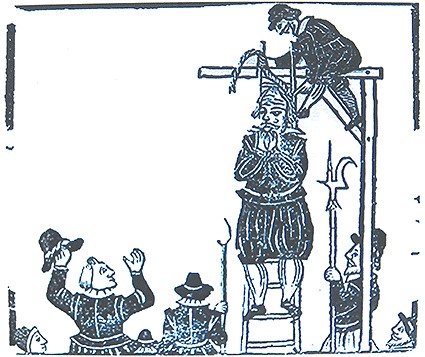
Steyning Museum Archives: Tudor Justice
When John Launder was burnt at the stake on Chantry Green it was because of sharp differences of belief. The state was intent on crushing what they perceived as heresy. The local courts, however, took care of more humdrum business.Coroners inquests, as they do now, dealt with deaths and these were quite often associated with animals or rural pursuits. For instance, when a ten year old boy fell from his perch 'on a redde mare (worth 5s 4d)', which was pulling his father’s cart, 'the mare then feloniously murdered him, giving him 3 mortal wounds on the head 3 inches long'.
Some of the intricacies of Tudor justice are also exemplified by an event which occurred in November 1547. James Farnfold, a gentleman of Steyning, and Edward Smythe of Wickham together with four of their friends from Henfield went out to John Leedes’ farm at Wappingthorne, on the Ashurst road, to do some rabbiting. They 'came armed and riotously assembled there, killed 2 of his rabbits worth 4d. with nets and pursenettes and assaulted William Horley and other of Leedes servants' who had come out to confront them. There 'James a Barowe, shoemaker, holding a bow and arrow in both hands, shot and murdered Horley, giving him a wound with the arrow in the left side to the heart of which he immediately died.' Barowe fled but not long afterwards he was caught and taken into custody from which, 'later on the same day, he feloniously escaped and (again) fled'. In the spring of 1548 all six of them were indicted for riot and homicide. Eventually Barowe appeared before the King’s Bench 'where he was acquitted of the murder, but his goods and chattels, worth £3, were forfeit because he had fled.'
This is not quite the end of this story. In 1555 John a Barowe (a relative of James – or misnamed by the clerk?) 'murdered William Suthecott with a staff worth Id. which he held in both hands, giving him a wound on the back of the head of which he immediately died'. His punishment was to be outlawed but a clerk noted on the court document that 'he had already been hanged at Steyning' – this, we think, being the only recorded instance of a hanging in the town.
One winter’s night in 1540 a group of young men were 'amusing and busying themselves' out at Wiston 'by 'batfowlyng'' [catching roosting birds by night with lights and poles, bats or nets]. A neighbour, coming into an adjoining croft armed with 'a pyked staff and seeing the men fowling said: 'What make you here, you knaves? I wold you durst come over the hedge.' One did just that and in the ensuing melee called out 'Why, knave, wilt thowe kyll me?'. But that, sadly, is what happened. The coroner’s inquest, on this occasion, took no action having concluded that William Philipson had been inadvertently 'feloniously killed by chance medley'.
Generally speaking, judgements appear to have been measured and exactly examined. So, in 1551, 'the pigs of Christian Kayne, widow, of Bramber, 'inkeper', went onto the land of William Battner of Bramber, 'inkeper', and were grazing and doing damage there. Battner's son John entered the land with his father's dog to drive the pigs off. Joan Davyd, Christian's servant, seeing him driving her mistress's pigs, entered the land, fought with John and beat the dog away from the pigs. Then William, seeing Joan on his land assaulting his son, went towards her, met her on 'a fote bridge' 4 feet wide and struck her on the right ear with his right hand. That blow was not the cause of her death, for long before she had been ill with 'le blake jawndes' [black jaundice] and it was of that that she died a natural death in Christian's house.'
These judgements allow us little insights into the rough and tumble of the Tudor world: it is just a shame that the same clerk was not on hand to describe the scene when John Launder was brought to his death.
Article by: Chris Tod - Steyning Museum.

